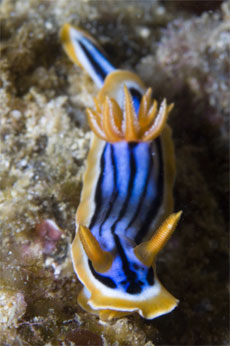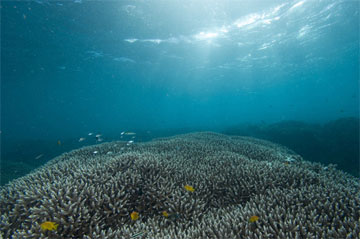Madagascar’s reefs escape damage from global warming
Madagascar’s reefs escape damage from global warming
Rhett A. Butler, mongabay.com
June 22, 2006
A survey of coral along Madagascar’s northeast coast suggests that they island’s reef may have so far escaped the damaging effects of warmer ocean temperatures attributed to global climate change.
Researchers from Conservation International (CI), a leading conservation group, found that the region’s coral reefs have avoided the bleaching that has affected other Indian Ocean reefs. The scientists believe that cool water currents from adjacent deep ocean areas have helped offset the warming effects of climate change.
The study comes as scientists are increasingly concerned for the long-term propects of coral reef ecosystems. Several studies have recently warned that the world’s coral reefs face a grim future should global temperatures and atmospheric concentrations of carbon dioxide continue to rise. Higher ocean temperatures will produce increasingly severe bleaching events, while elevated levels of carbon dioxide could further acidify the world’s seas. Ove Hoegh-Guldberg, head of the University of Queensland’s Centre for Marine Studies, believes that Australia’s Great Barrier Reef — the world’s largest reef — could lose 95 percent of its living coral by 2050 should ocean temperatures increase by the 1.5 degrees Celsius projected by climate scientists.
 Nudibranch (Chromodoris elisabethina) photographed at a survey site on the CI Marine RAP (Rapid Assessment Program) expedition to northeast Madagascar, March 2006. By Sterling Zumbrunn. |
Nevertheless, after conducting two Rapid Assessment Program (RAP) expeditions, the CI team found some signs indicating Madagascar’s marine ecosystems are healthy. The scientists recorded the highest coral diversity of the western Indian Ocean and the Red Sea and documented 18 species of fish never before seen in the waters off Madagascar, including one believed new to science. The survey suggests the region one of the richest in Indian Ocean marine biodiversity, with 829 species of fish now known from Malagasy waters.
“In the end, these expeditions have doubled the number of marine species known to the region,” said Sheila McKenna, director of marine biodiversity for CI’s Center for Applied Biodiversity Science. “That demonstrates the need to protect these areas.”
CI says the latest results provide further information for marine conservation efforts in the country. President Marc Ravalomanana has already pledged to triple the island nation’s total protected areas to 6 million hectares (23,000 square miles), including 1 million hectares (3,800 square miles) of marine protected areas.
“The resiliency and health of the coral reefs with their biodiversity and endemism makes the reefs of Madagascar a high conservation priority,” said Gerald R. Allen, an ichthyologist who conducted underwater fish surveys on the expedition which took place from March 10-24 in the region between Cape d’ Ambre and Baie du Loky.
 At some survey sites, there was a very high percentage of coral coverage during the CI Marine RAP (Rapid Assessment Program) expedition to northeast Madagascar, March 2006. By Sterling Zumbrunn. CORAL BLEACHING |
Despite the latest discoveries, the researchers say still much is to be learned about Madagascar’s marine diversity, which includes more than 1,000 kilometers of coral reef and rich feeding grounds for whales, turtles, and sharks.
Jean Maharavo of Madagascar’s National Center for Environmental Research, who took part in both expeditions, said that much of the island nation’s marine biodiversity has yet to be studied.
“During each of these two expeditions, we discovered new fish and coral species,” Maharavo noted. “That shows the need to protect what’s out there before we lose biodiversity that we never even knew existed.”
RELATED ARTICLES
Global warming may cause permanent damage to coral reefs May 15, 2006
Global warming has had a more devastating impact on coral reefs than previously believed says a new study published in the Proceedings of the National Academy of Sciences. The research, the first to show the long-term impact of rising sea temperatures on coral and fish communities, suggests that “large sections of coral reefs and much of the marine life they support may be wiped out for good,” according to a news release from the University of Newcastle upon Tyne, an institution involved in the project.
Coral reefs decimated by 2050, Great Barrier Reef’s coral 95% dead November 17, 2005
Australia’s Great Barrier Reef could lose 95 percent of its living coral by 2050 should ocean temperatures increase by the 1.5 degrees Celsius projected by climate scientists. The startling and controversial prediction, made last year in a report commissioned by the World Worldwide Fund for Nature (WWF) and the Queensland government, is just one of the dire scenarios forecast for reefs in the near future. The degradation and possible disappearance of these ecosystems would have profound socioeconomic ramifications as well as ecological impacts says Ove Hoegh-Guldberg, head of the University of Queensland’s Centre for Marine Studies.
Tourism in Madagascar; Visiting the World’s Most Unusual Island September 9, 2005
My tent is perched atop a forested bank over-looking a clear, fast-moving stream. As I sit recording notes from a days’ worth of hiking through narrow fern-lined canyons I am startled by a loud meow. Looking up, I am face to face with a bored-looking ring-tailed lemur. Her beady amber eyes stare back at me as she meows again. A second head appears. She’s carrying a young lemur on her back. A few moments later she arrogantly swaggers away. I stumble to my feet and climb out of the tent to find myself surrounded by ring-tails. Their indifference towards me is strangely comforting in this charming yet decidedly peculiar land.
RELATED LINKS
Photos from the Madagascar marine RAP
Information about the Rapid Assessment Program (RAP)
Conservation International